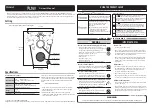
Proline Promass 84F
Hauser
15
Orientation
Make sure that the direction of the arrow on the nameplate of the sensor matches the direction of flow
(direction in which the fluid flows through the pipe).
Vertical (View V)
Recommended orientation with upward direction of flow (View V). When fluid is not flowing, entrained solids
will sink down and gases will rise away from the measuring tube. The measuring tubes can be completely
drained and protected against solids build-up.
Horizontal (Views H1, H2)
The measuring tubes must be horizontal and beside each other. When installation is correct the transmitter
housing is above or below the pipe (View H1, H2). Always avoid having the transmitter housing in the same
horizontal plane as the pipe. Please note the special installation instructions
→
ä
16.
In order to ensure that the maximum permissible ambient temperature for the transmitter is not exceeded, we
recommend the following orientations:
m
= For fluids with low temperatures, we recommend the horizontal orientation with the transmitter head
pointing upwards (View H1) or the vertical orientation (View V).
n
= For fluids with high-temperatures, >200 °C (>392 °F), we recommend the horizontal orientation with
the transmitter head pointing downwards (View H2) or the vertical orientation (View V).
DN
∅
Orifice plate, pipe restriction
[mm]
[inch]
mm
inch
8
3/8"
6
0.24
15
½"
10
0.40
25
1"
14
0.55
40
1½"
22
0.87
50
2"
28
1.10
80
3"
50
2.00
100
4"
65
2.60
150
6"
90
3.54
250
10"
150
5.91
Orientation
Vertical
Horizontal,
Transmitter head up
Horizontal,
Transmitter head down
a0004572
View V
a0004576
View H1
a0004580
View H2
Standard,
Compact version
ÃÃ
ÃÃ
ÃÃ
n
Standard,
Remote version
ÃÃ
ÃÃ
ÃÃ
n
High-temperature,
Compact version
ÃÃ
✘
m
TM > 200 °C (> 392°F)
ÃÃ
n
High-temperature,
Remote version
ÃÃ
✘
m
TM > 200 °C (> 392°F)
ÃÃ
n
ÃÃ
= Recommended orientation;
Ã
= Orientation recommended in certain situations;
✘
= Impermissible orientation
















































